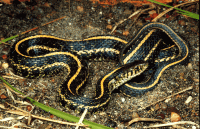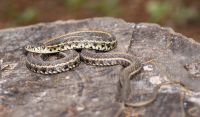Thamnophis radix (Baird & Girard, 1853)


Key Characters: Side stripes on scale rows 3-4; orange-yellow midback stripe; black bars on the margins of labial scales; back scales keeled; anal plate not divided.
Similar Species: Eastern Ribbonsnake, Western Ribbonsnake, Common Gartersnake, Lined snake. See the Key to Snakes of Illinois for help with identification.
Subspecies: None currently recognized.
Description: Medium-sized (up to 100 cm TL) dark brown or black snake with an orange-yellow midback strip and a yellow-gray stripe on each side. Two rows of alternating black spots or blotches on the side. Belly gray-green with dark spots along the edges. Usually a pair of light spots on top of the head.
Habitat: Former black-soil prairies, cultivated fields, pastures, wet meadows and marshes, and vacant lots.
Natural History: One of the most cold-tolerant snakes, often emerging from hibernation to bask on warm, sunny winter days. Mates in April or May and gives birth to 5-30 young from August through early October. Newborn 15-25 cm TL. Does not bite as readily as the common garter snake when handled. Common prey are earthworms, slugs, and small amphibians. Predators include birds of prey, mammals, and other snakes. Large numbers are killed on roads each spring and autumn as they move to and from upland hibernacula.
Status: Common in the northern half of the state.
Etymology: Thamnophis – thamnos (Greek) meaning shrub, bush; ophio (Greek) meaning serpent, reptile; radix – (Latin) meaning root.
Original Description: Baird S.F. & C. Girard. 1853. Catalogue of North American reptiles in the Museum of the Smithsonian Institution. Part I. Serpents. Smithsonian Misc, Coll. 2(5):172 pp.
Type Specimen: Holotype. USNM?.
Type Locality: “Racine, Wisconsin”
Original Name: Eutainia radix Baird & Girard, 1853
Nomenclatural History: This species has a very complicated nomenclatural history. Kennicott (1855) emended the name to Eutania, Hay (1881) to Eutaenia and S. Garman (1884) transferred it to Tropidonotus. For a time it was considered a subspecies of Thamnophis ordinatus (but as Tropidonotus ordinatus radix).


